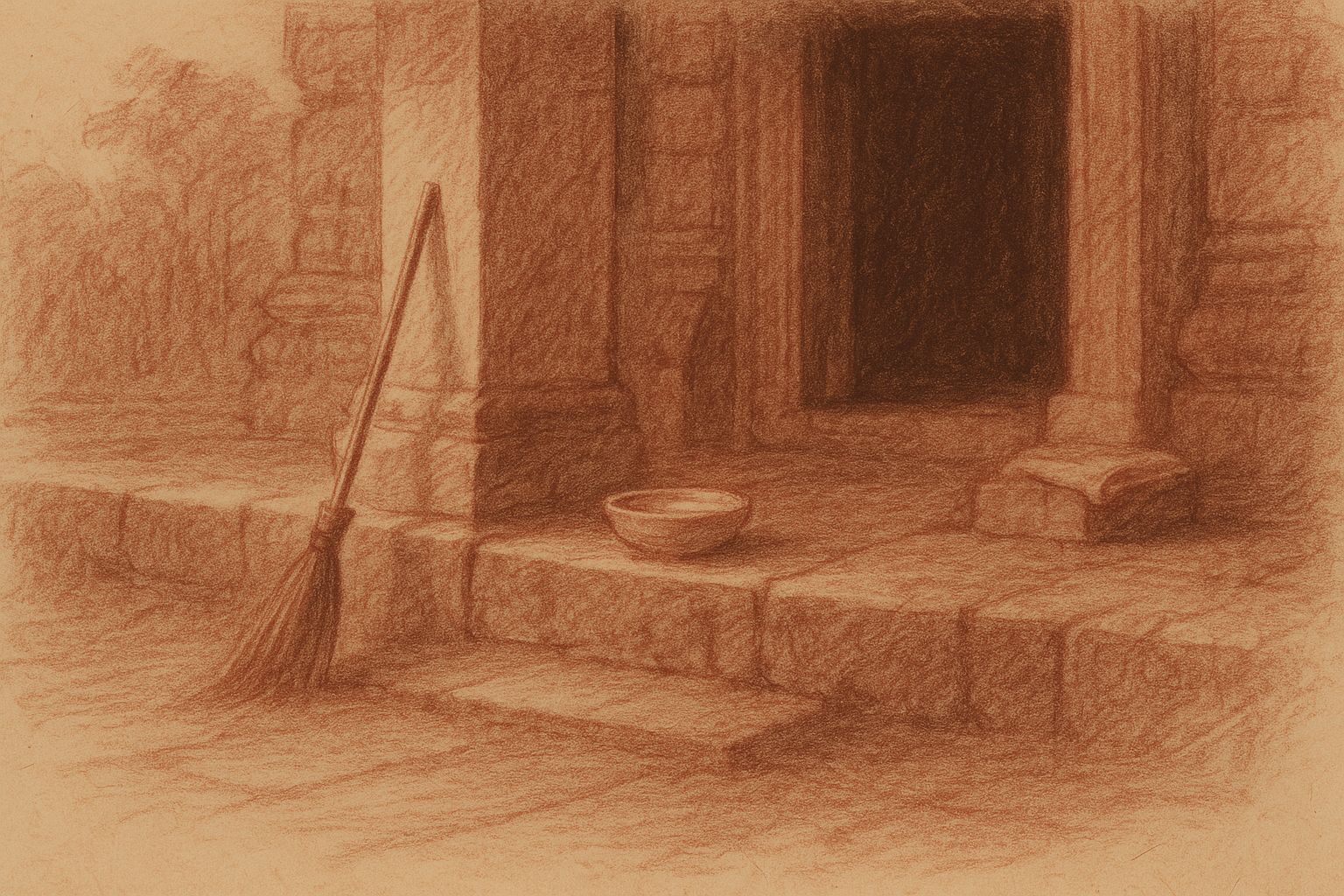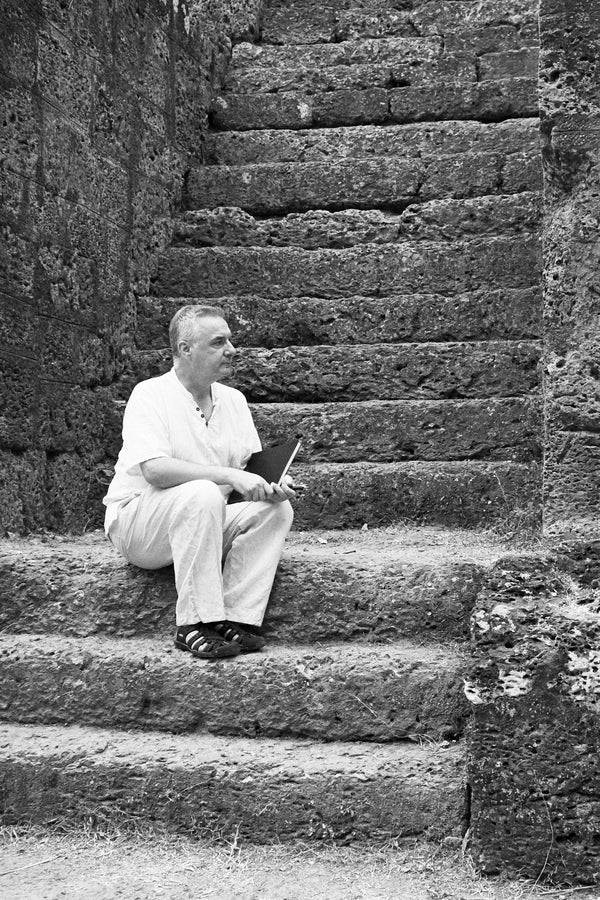Complimentary worldwide shipping on orders over $400 · No import tariffs for most countries
Complimentary worldwide shipping on orders over $400 · No import tariffs for most countries

In the Stillness That Watches
1 min read
The causeway glistened as though the night had just passed through it. Above, the clouds barely moved. There was no wind, not even the anticipation of wind—only an immense listening.
The naga balustrades curved ahead, dissolving into mist. Their rhythm wasn’t architectural—it was liturgical. Each carved coil echoed something I felt in the chest, not the eyes. And the towers—still veiled—waited beyond sound.
I paused there for some time. No need to arrange the world. It had already arranged me.
The exposure was long. I imagined it not as an act of photography, but as the breath between one world and the next.
The image emerged slowly, as it had in life. In the darkroom, the shadows told me where to begin. I shaped the light with restraint. Hand-toned each print as though the stones themselves were whispering through silver.
Not all doors are closed.
Some wait in stillness,
not to be opened
but crossed.Beneath a sky veiled in breath,
the stone recalls
every footfall,
every vow left
unsaid.The naga curls
into the unseen—
its silence more faithful
than sound.And I—
not entering,
not leaving—
stand
where light has not yet taken form.
Also in Library

Before the Shutter Falls
3 min read
Before the shutter falls, fear sharpens and doubt measures the cost of waiting. In the quiet hours before dawn, the act of not-yet-beginning becomes a discipline of attention. This essay reflects on patience, restraint, and the quiet mercy that arrives when outcome loosens its hold.

Those Who Keep the Way Open — On the Quiet Guardians of Angkor’s Thresholds
3 min read
Quiet gestures shape the way into Angkor — a swept stone, a refilled bowl, a hand steadying a guardian lion. This essay reflects on the unseen custodians whose daily care keeps the thresholds open, revealing how sacredness endures not through stone alone, but through those who tend its meaning.

Multiplicity and Mercy — The Face Towers of Jayavarman VII
5 min read
A new vision of kingship rises at the Bayon: serene faces turned to every horizon, shaping a world where authority is expressed as care. Moving through the terraces, one enters a field of steady, compassionate presence — a landscape where stone, light, and time teach through quiet attention.
Angkor Wat Temple, Angkor, Cambodia — 2020
Limited Edition Archival Pigment Print
Edition
Strictly limited to 25 prints + 2 Artist’s Proofs
Medium
Hand-toned black-and-white archival pigment print on Hahnemühle Bamboo — a museum-grade fine art paper chosen for its quiet tactility and reverent depth, echoing the spirit of the temples.
Signature & Numbering
Each print is individually signed and numbered by the artist on the border (recto)
Certificate of Authenticity
Accompanies every print
Image Size
8 x 8 inches (20.3 x 20.3 cm)
Before first light touches stone, before the world is named, the western causeway of Angkor Wat extends like a breath held in the body of the earth. No footsteps echo. The sky holds its silence in cloudlight.
The naga balustrades curve inward like gestures of remembrance. Their symmetry does not lead to a structure, but to presence. The temple’s towers wait on the horizon, not to be seen—but to be met. Here, in the hush before form, something sacred begins.
Lucas Varro entered this space before dawn, passing through the western gopura in darkness. He stood without framing or thought, listening. The camera’s bellows opened like a breath. The long exposure received not an image, but a moment of surrender.
Captured on large format black-and-white film, the photograph was shaped using classical chiaroscuro techniques and hand-toned by the artist. The final print is an archival pigment print on Hahnemühle Bamboo paper, offered in a strictly limited edition of 25 + 2 Artist’s Proofs.
Each one a threshold, waiting to be crossed in silence.
Click here to enter the Artist’s Journal and walk deeper into the hush.
Previously titled ‘Causeway, Angkor Wat Temple, Cambodia. 2020,’ this photograph has been renamed to better reflect its place in the series and its spiritual tone. The edition, provenance, and authenticity remain unchanged.
Join My Studio Journal
Receive occasional letters from my studio in Siem Reap—offering a glimpse into my creative process, early access to new fine art prints, field notes from the temples of Angkor, exhibition announcements, and reflections on beauty, impermanence, and the spirit of place.
No noise. No clutter. Just quiet inspiration, delivered gently.
Subscribe and stay connected to the unfolding story.

Join My Studio Journal
Receive occasional letters from my studio in Siem Reap—offering a glimpse into my creative process, early access to new fine art prints, field notes from the temples of Angkor, exhibition announcements, and reflections on beauty, impermanence, and the spirit of place.
No noise. No clutter. Just quiet inspiration, delivered gently.
Subscribe and stay connected to the unfolding story.

